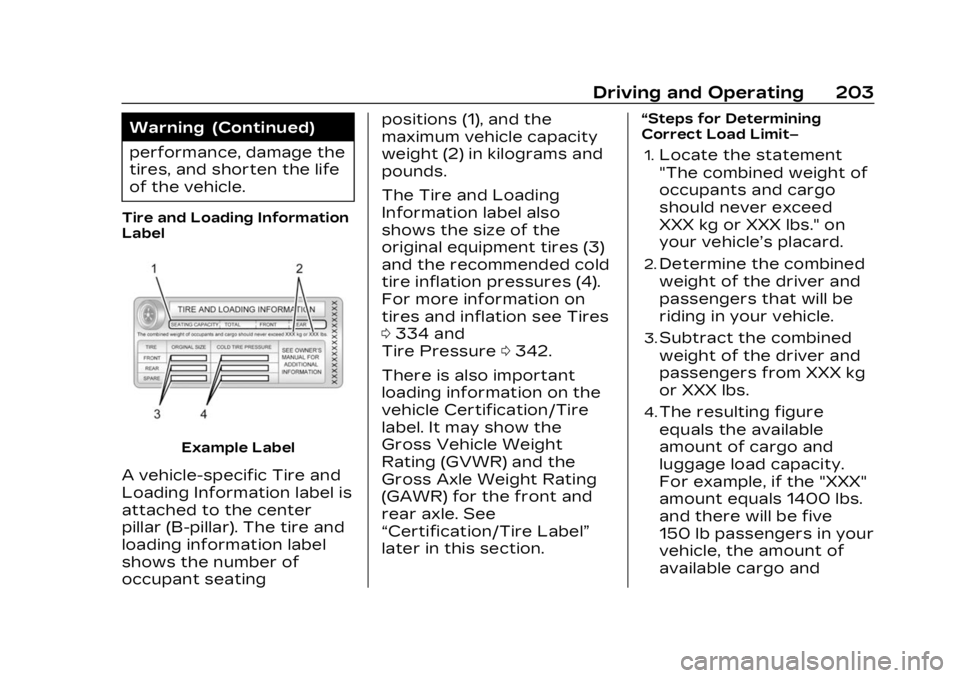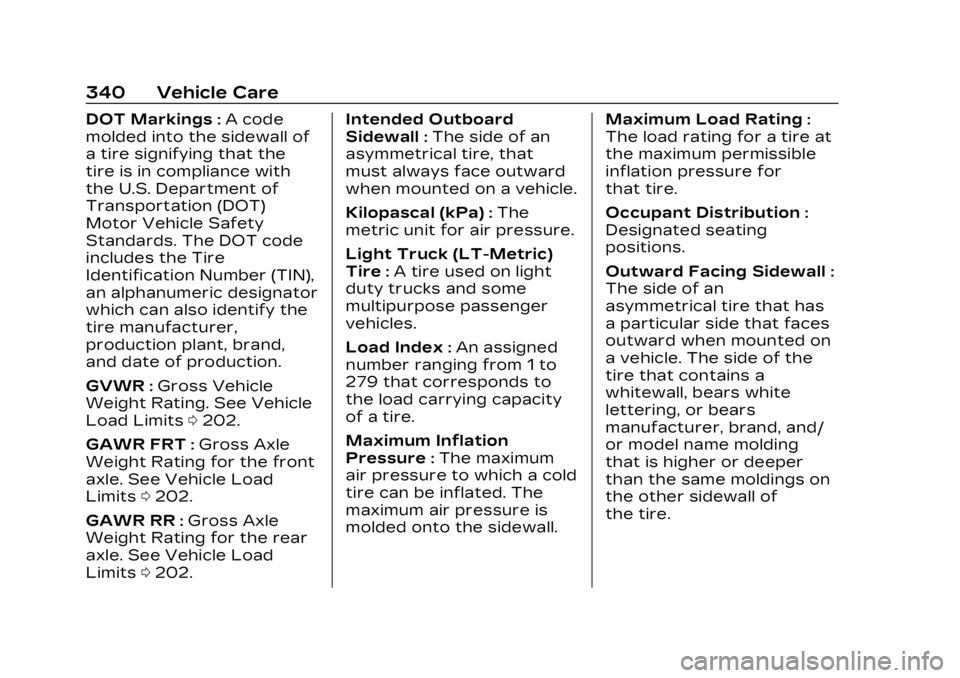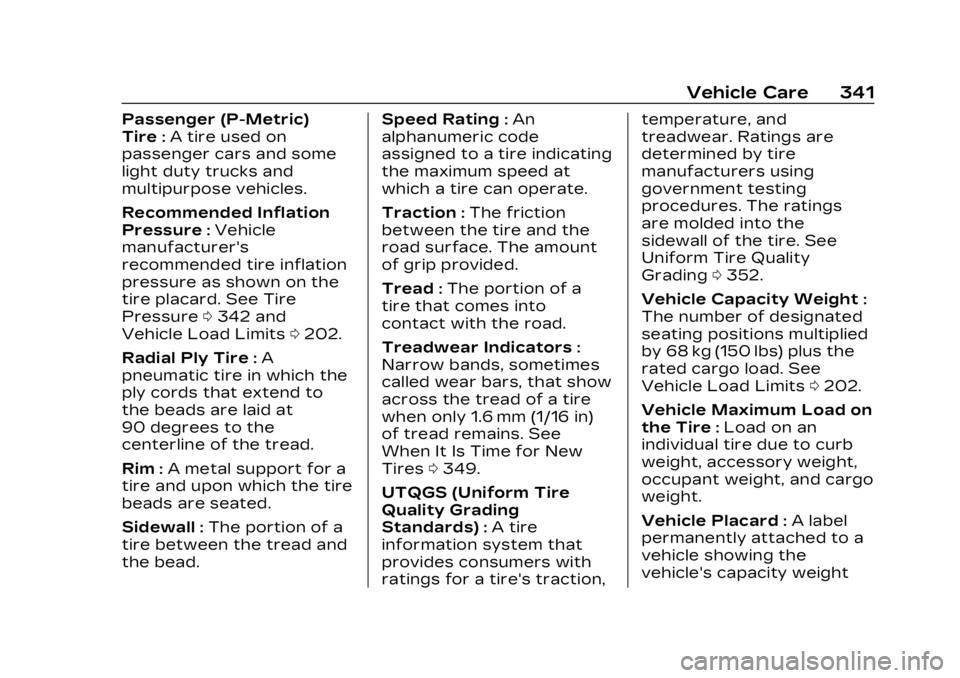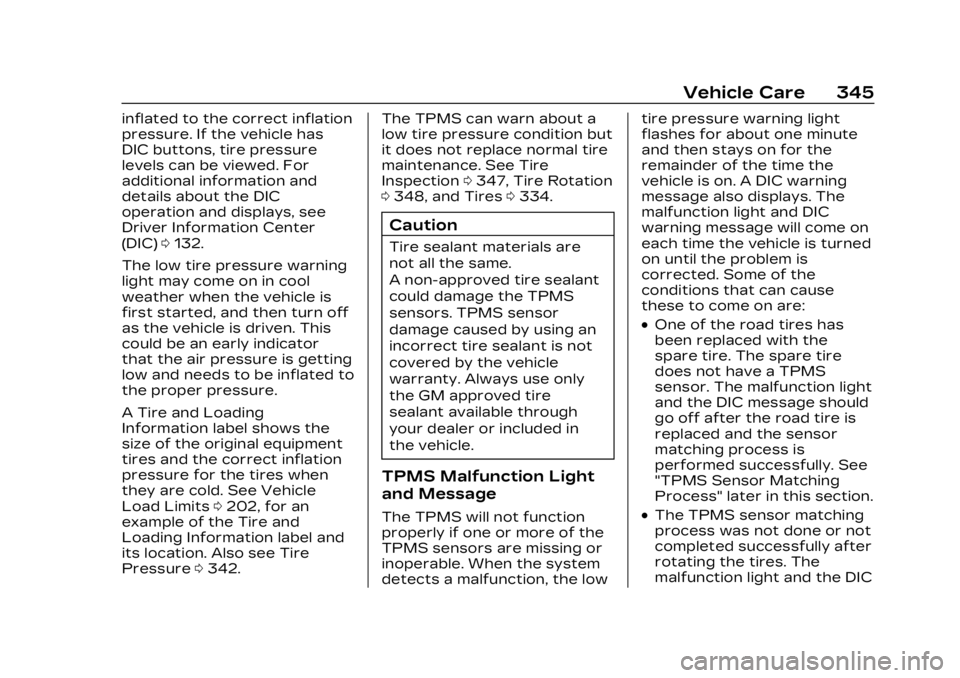inflation pressure CADILLAC LYRIC 2023 Owners Manual
[x] Cancel search | Manufacturer: CADILLAC, Model Year: 2023, Model line: LYRIC, Model: CADILLAC LYRIC 2023Pages: 424, PDF Size: 4.76 MB
Page 204 of 424

Cadillac Lyriq Owner Manual (GMNA-Localizing-U.S./Canada-15644413) -
2023 - CRC - 2/23/22
Driving and Operating 203
Warning (Continued)
performance, damage the
tires, and shorten the life
of the vehicle.
Tire and Loading Information
Label
Example Label
A vehicle-specific Tire and
Loading Information label is
attached to the center
pillar (B-pillar). The tire and
loading information label
shows the number of
occupant seatingpositions (1), and the
maximum vehicle capacity
weight (2) in kilograms and
pounds.
The Tire and Loading
Information label also
shows the size of the
original equipment tires (3)
and the recommended cold
tire inflation pressures (4).
For more information on
tires and inflation see Tires
0
334 and
Tire Pressure 0342.
There is also important
loading information on the
vehicle Certification/Tire
label. It may show the
Gross Vehicle Weight
Rating (GVWR) and the
Gross Axle Weight Rating
(GAWR) for the front and
rear axle. See
“Certification/Tire Label”
later in this section.
“Steps for Determining
Correct Load Limit– 1.
Locate the statement
"The combined weight of
occupants and cargo
should never exceed
XXX kg or XXX lbs." on
your vehicle’s placard.
2.Determine the combined
weight of the driver and
passengers that will be
riding in your vehicle.
3.Subtract the combined
weight of the driver and
passengers from XXX kg
or XXX lbs.
4.The resulting figure
equals the available
amount of cargo and
luggage load capacity.
For example, if the "XXX"
amount equals 1400 lbs.
and there will be five
150 lb passengers in your
vehicle, the amount of
available cargo and
Page 206 of 424

Cadillac Lyriq Owner Manual (GMNA-Localizing-U.S./Canada-15644413) -
2023 - CRC - 2/23/22
Driving and Operating 205
Example 3
1.Vehicle Capacity
Weight for Example 3 =
453 kg (1,000 lbs).
2.Subtract Occupant
Weight @ 91 kg
(200 lbs) × 5 = 453 kg
(1,000 lbs).
3.Available Cargo Weight
= 0 kg (0 lbs).
Refer to the vehicle's tire
and loading information
label for specific
information about the
vehicle's capacity weight and seating positions. The
combined weight of the
driver, passengers, and
cargo should never exceed
the vehicle's capacity
weight.
Certification/Tire Label
Label Example
A vehicle-specific
Certification/Tire label is
attached to the center
pillar (B-pillar).
The label may show the
size of the vehicle's original
tires and the inflationpressures needed to obtain
the gross weight capacity
of the vehicle. The label
shows the gross weight
capacity of the vehicle. This
is called the Gross Vehicle
Weight Rating (GVWR). The
GVWR includes the weight
of the vehicle, all
occupants, and cargo.
The Certification/Tire label
may also show the
maximum weights for the
front and rear axles, called
the Gross Axle Weight
Rating (GAWR). To find out
the actual loads on the
front and rear axles, weigh
the vehicle at a weigh
station. Your dealer can
help with this. Be sure to
spread the load equally on
both sides of the
centerline.
Page 338 of 424

Cadillac Lyriq Owner Manual (GMNA-Localizing-U.S./Canada-15644413) -
2023 - CRC - 2/23/22
Vehicle Care 337
vehicle does not come with a
spare tire or tire changing
equipment.
Low-Profile Tires
If the vehicle has
265/50R20 or 275/40R22
size tires, they are
classified as low-profile
tires.Caution
Low-profile tires are more
susceptible to damage from
road hazards or curb impact
than standard profile tires.
Tire and/or wheel assembly
damage can occur when
coming into contact with
road hazards like potholes,
or sharp edged objects,
or when sliding into a curb.
The warranty does not
cover this type of damage.
Keep tires set to the correct
inflation pressure and when (Continued)
Caution (Continued)
possible, avoid contact with
curbs, potholes, and other
road hazards.
Tire Sidewall Labeling
Useful information about a
tire is molded into its
sidewall. The example
shows a typical passenger
tire sidewall.
Passenger Tire Example
(1) Tire Size:The tire size
is a combination of letters
and numbers used to
define a particular tire's
width, height, aspect ratio,
construction type, and
service description. See the
“Tire Size” illustration later
in this section.
(2) TPC Spec (Tire
Performance Criteria
Specification)
:Original
equipment tires designed
to GM's specific tire
performance criteria have a
TPC specification code
molded onto the sidewall.
GM's TPC specifications
meet or exceed all federal
safety guidelines.
(3) DOT (Department of
Transportation)
:The
Department of
Transportation (DOT) code
indicates that the tire is in
compliance with the U.S.
Page 339 of 424

Cadillac Lyriq Owner Manual (GMNA-Localizing-U.S./Canada-15644413) -
2023 - CRC - 2/23/22
338 Vehicle Care
Department of
Transportation Motor
Vehicle Safety Standards.
DOT Tire Date of
Manufacture
:The last
four digits of the TIN
indicate the tire
manufactured date. The
first two digits represent
the week and the last two
digits, the year. For
example, the third week of
the year 2020 would have
a 4-digit DOT date of 0320.
Week 01 is the first full
week (Sunday through
Saturday) of each year.
(4) Tire Identification
Number (TIN)
:The letters
and numbers following the
DOT code are the Tire
Identification Number (TIN).
The TIN shows the
manufacturer and plant
code, tire size, and date the
tire was manufactured. The TIN is molded onto both
sides of the tire, although
only one side may have the
date of manufacture.
(5) Tire Ply Material
:The
type of cord and number of
plies in the sidewall and
under the tread.
(6) Uniform Tire Quality
Grading (UTQG)
:Tire
manufacturers are required
to grade tires based on
three performance factors:
treadwear, traction, and
temperature resistance.
For more information, see
Uniform Tire Quality
Grading 0352.
(7) Maximum Cold
Inflation Load Limit
:
Maximum load that can be
carried and the maximum
pressure needed to
support that load.
Tire Designations
Tire Size
The example shows a
typical passenger vehicle
tire size.
Passenger (P-Metric) Tire
(1) Passenger (P-Metric)
Tire
:The United States
version of a metric tire
sizing system. The letter
"P" as the first character in
the tire size means a
passenger vehicle tire
engineered to standards
set by the U.S. Tire and Rim
Association.
Page 341 of 424

Cadillac Lyriq Owner Manual (GMNA-Localizing-U.S./Canada-15644413) -
2023 - CRC - 2/23/22
340 Vehicle Care
DOT Markings:A code
molded into the sidewall of
a tire signifying that the
tire is in compliance with
the U.S. Department of
Transportation (DOT)
Motor Vehicle Safety
Standards. The DOT code
includes the Tire
Identification Number (TIN),
an alphanumeric designator
which can also identify the
tire manufacturer,
production plant, brand,
and date of production.
GVWR
:Gross Vehicle
Weight Rating. See Vehicle
Load Limits 0202.
GAWR FRT
:Gross Axle
Weight Rating for the front
axle. See Vehicle Load
Limits 0202.
GAWR RR
:Gross Axle
Weight Rating for the rear
axle. See Vehicle Load
Limits 0202. Intended Outboard
Sidewall
:The side of an
asymmetrical tire, that
must always face outward
when mounted on a vehicle.
Kilopascal (kPa)
:The
metric unit for air pressure.
Light Truck (LT-Metric)
Tire
:A tire used on light
duty trucks and some
multipurpose passenger
vehicles.
Load Index
:An assigned
number ranging from 1 to
279 that corresponds to
the load carrying capacity
of a tire.
Maximum Inflation
Pressure
:The maximum
air pressure to which a cold
tire can be inflated. The
maximum air pressure is
molded onto the sidewall. Maximum Load Rating
:
The load rating for a tire at
the maximum permissible
inflation pressure for
that tire.
Occupant Distribution
:
Designated seating
positions.
Outward Facing Sidewall
:
The side of an
asymmetrical tire that has
a particular side that faces
outward when mounted on
a vehicle. The side of the
tire that contains a
whitewall, bears white
lettering, or bears
manufacturer, brand, and/
or model name molding
that is higher or deeper
than the same moldings on
the other sidewall of
the tire.
Page 342 of 424

Cadillac Lyriq Owner Manual (GMNA-Localizing-U.S./Canada-15644413) -
2023 - CRC - 2/23/22
Vehicle Care 341
Passenger (P-Metric)
Tire
:A tire used on
passenger cars and some
light duty trucks and
multipurpose vehicles.
Recommended Inflation
Pressure
:Vehicle
manufacturer's
recommended tire inflation
pressure as shown on the
tire placard. See Tire
Pressure 0342 and
Vehicle Load Limits 0202.
Radial Ply Tire
:A
pneumatic tire in which the
ply cords that extend to
the beads are laid at
90 degrees to the
centerline of the tread.
Rim
:A metal support for a
tire and upon which the tire
beads are seated.
Sidewall
:The portion of a
tire between the tread and
the bead. Speed Rating
:An
alphanumeric code
assigned to a tire indicating
the maximum speed at
which a tire can operate.
Traction
:The friction
between the tire and the
road surface. The amount
of grip provided.
Tread
:The portion of a
tire that comes into
contact with the road.
Treadwear Indicators
:
Narrow bands, sometimes
called wear bars, that show
across the tread of a tire
when only 1.6 mm (1/16 in)
of tread remains. See
When It Is Time for New
Tires 0349.
UTQGS (Uniform Tire
Quality Grading
Standards)
:A tire
information system that
provides consumers with
ratings for a tire's traction, temperature, and
treadwear. Ratings are
determined by tire
manufacturers using
government testing
procedures. The ratings
are molded into the
sidewall of the tire. See
Uniform Tire Quality
Grading
0352.
Vehicle Capacity Weight
:
The number of designated
seating positions multiplied
by 68 kg (150 lbs) plus the
rated cargo load. See
Vehicle Load Limits 0202.
Vehicle Maximum Load on
the Tire
:Load on an
individual tire due to curb
weight, accessory weight,
occupant weight, and cargo
weight.
Vehicle Placard
:A label
permanently attached to a
vehicle showing the
vehicle's capacity weight
Page 343 of 424

Cadillac Lyriq Owner Manual (GMNA-Localizing-U.S./Canada-15644413) -
2023 - CRC - 2/23/22
342 Vehicle Care
and the original equipment
tire size and recommended
inflation pressure. See“Tire
and Loading Information
Label” under Vehicle Load
Limits 0202.
Tire Pressure
Tires need the correct
amount of air pressure to
operate effectively.
{Warning
Neither tire underinflation
nor overinflation is good.
Underinflated tires,
or tires that do not have
enough air, can result in:
.Tire overloading and
overheating, which
could lead to a blowout
.Premature or
irregular wear
.Poor handling
(Continued)
Warning (Continued)
.Reduced fuel economy
for internal combustion
engine vehicles
.Reduced range for
electric vehicles
Overinflated tires, or tires
that have too much air,
can result in:
.Unusual wear
.Poor handling
.Rough ride
.Needless damage from
road hazards
The Tire and Loading
Information label on the
vehicle indicates the
original equipment tires
and the correct cold tire
inflation pressures. The
recommended pressure is
the minimum air pressure
needed to support the vehicle's maximum load
carrying capacity. See
Vehicle Load Limits
0202.
How the vehicle is loaded
affects vehicle handling
and ride comfort. Never
load the vehicle with more
weight than it was
designed to carry.
When to Check
Check the pressure of the
tires once a month or more.
How to Check
Use a good quality
pocket-type gauge to
check tire pressure. Proper
tire inflation cannot be
determined by looking at
the tire. Check the tire
inflation pressure when the
tires are cold, meaning the
vehicle has not been driven
for at least three hours or
no more than 1.6 km (1 mi).
Page 344 of 424

Cadillac Lyriq Owner Manual (GMNA-Localizing-U.S./Canada-15644413) -
2023 - CRC - 2/23/22
Vehicle Care 343
Remove the valve cap from
the tire valve stem. Press
the tire gauge firmly onto
the valve to get a pressure
measurement. If the cold
tire inflation pressure
matches the recommended
pressure on the Tire and
Loading Information label,
no further adjustment is
necessary. If the inflation
pressure is low, add air
until the recommended
pressure is reached. If the
inflation pressure is high,
press on the metal stem in
the center of the tire valve
to release air.
Recheck the tire pressure
with the tire gauge.
Put the valve caps back on
the valve stems to keep out
dirt and moisture. Use only
valve caps designed for the
vehicle by GM. TPMSsensors could be damaged
and would not be covered
by the vehicle warranty.
Tire Pressure Monitor
System
The Tire Pressure Monitor
System (TPMS) uses radio and
sensor technology to check
tire pressure levels. The TPMS
sensors monitor the air
pressure in your tires and
transmit tire pressure
readings to a receiver located
in the vehicle.
Each tire, including the spare
(if provided), should be
checked monthly when cold
and inflated to the inflation
pressure recommended by the
vehicle manufacturer on the
vehicle placard or tire inflation
pressure label. (If your vehicle
has tires of a different size
than the size indicated on the
vehicle placard or tire inflation
pressure label, you should determine the proper tire
inflation pressure for those
tires.)
As an added safety feature,
your vehicle has been
equipped with a tire pressure
monitoring system (TPMS)
that illuminates a low tire
pressure telltale when one or
more of your tires is
significantly under-inflated.
Accordingly, when the low tire
pressure telltale illuminates,
you should stop and check
your tires as soon as possible,
and inflate them to the proper
pressure. Driving on a
significantly under-inflated tire
causes the tire to overheat
and can lead to tire failure.
Under-inflation also reduces
energy efficiency and tire
tread life, and may affect the
vehicle's handling and
stopping ability.
Please note that the TPMS is
not a substitute for proper tire
maintenance, and it is the
driver's responsibility to
Page 345 of 424

Cadillac Lyriq Owner Manual (GMNA-Localizing-U.S./Canada-15644413) -
2023 - CRC - 2/23/22
344 Vehicle Care
maintain correct tire pressure,
even if under-inflation has not
reached the level to trigger
illumination of the TPMS low
tire pressure telltale.
Your vehicle has also been
equipped with a TPMS
malfunction indicator to
indicate when the system is
not operating properly. The
TPMS malfunction indicator is
combined with the low tire
pressure telltale. When the
system detects a malfunction,
the telltale will flash for
approximately one minute and
then remain continuously
illuminated. This sequence will
continue upon subsequent
vehicle start-ups as long as
the malfunction exists.
When the malfunction
indicator is illuminated, the
system may not be able to
detect or signal low tire
pressure as intended. TPMS
malfunctions may occur for a
variety of reasons, including
the installation of replacementor alternate tires or wheels on
the vehicle that prevent the
TPMS from functioning
properly. Always check the
TPMS malfunction telltale
after replacing one or more
tires or wheels on your vehicle
to ensure that the
replacement or alternate tires
and wheels allow the TPMS to
continue to function properly.
See Tire Pressure Monitor
Operation
0344.
See Radio Frequency
Statement 0395.
Tire Pressure Monitor
Operation
This vehicle may have a Tire
Pressure Monitor System
(TPMS). The TPMS is designed
to warn the driver when a low
tire pressure condition exists.
TPMS sensors are mounted
onto each tire and wheel
assembly, excluding the spare
tire and wheel assembly. The
TPMS sensors monitor the air
pressure in the tires and transmit the tire pressure
readings to a receiver located
in the vehicle.
When a low tire pressure
condition is detected, the
TPMS illuminates the low tire
pressure warning light located
on the instrument cluster.
If the warning light comes on,
stop as soon as possible and
inflate the tires to the
recommended pressure
shown on the Tire and
Loading Information label. See
Vehicle Load Limits
0202.
A message to check the
pressure in a specific tire
displays in the Driver
Information Center (DIC). The
low tire pressure warning light
and the DIC warning message
come on each time the vehicle
is turned on until the tires are
Page 346 of 424

Cadillac Lyriq Owner Manual (GMNA-Localizing-U.S./Canada-15644413) -
2023 - CRC - 2/23/22
Vehicle Care 345
inflated to the correct inflation
pressure. If the vehicle has
DIC buttons, tire pressure
levels can be viewed. For
additional information and
details about the DIC
operation and displays, see
Driver Information Center
(DIC)0132.
The low tire pressure warning
light may come on in cool
weather when the vehicle is
first started, and then turn off
as the vehicle is driven. This
could be an early indicator
that the air pressure is getting
low and needs to be inflated to
the proper pressure.
A Tire and Loading
Information label shows the
size of the original equipment
tires and the correct inflation
pressure for the tires when
they are cold. See Vehicle
Load Limits 0202, for an
example of the Tire and
Loading Information label and
its location. Also see Tire
Pressure 0342. The TPMS can warn about a
low tire pressure condition but
it does not replace normal tire
maintenance. See Tire
Inspection
0347, Tire Rotation
0 348, and Tires 0334.
Caution
Tire sealant materials are
not all the same.
A non-approved tire sealant
could damage the TPMS
sensors. TPMS sensor
damage caused by using an
incorrect tire sealant is not
covered by the vehicle
warranty. Always use only
the GM approved tire
sealant available through
your dealer or included in
the vehicle.
TPMS Malfunction Light
and Message
The TPMS will not function
properly if one or more of the
TPMS sensors are missing or
inoperable. When the system
detects a malfunction, the low tire pressure warning light
flashes for about one minute
and then stays on for the
remainder of the time the
vehicle is on. A DIC warning
message also displays. The
malfunction light and DIC
warning message will come on
each time the vehicle is turned
on until the problem is
corrected. Some of the
conditions that can cause
these to come on are:
.One of the road tires has
been replaced with the
spare tire. The spare tire
does not have a TPMS
sensor. The malfunction light
and the DIC message should
go off after the road tire is
replaced and the sensor
matching process is
performed successfully. See
"TPMS Sensor Matching
Process" later in this section.
.The TPMS sensor matching
process was not done or not
completed successfully after
rotating the tires. The
malfunction light and the DIC